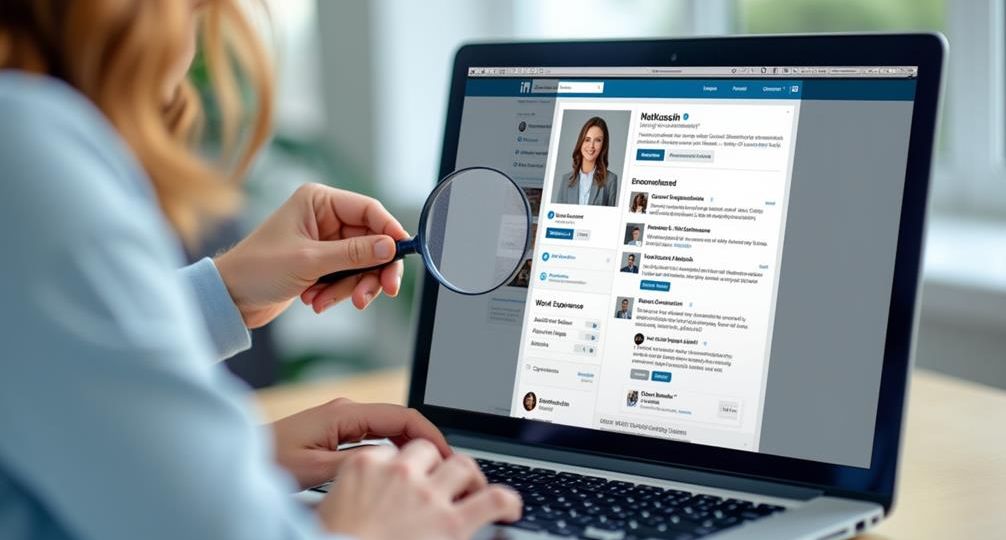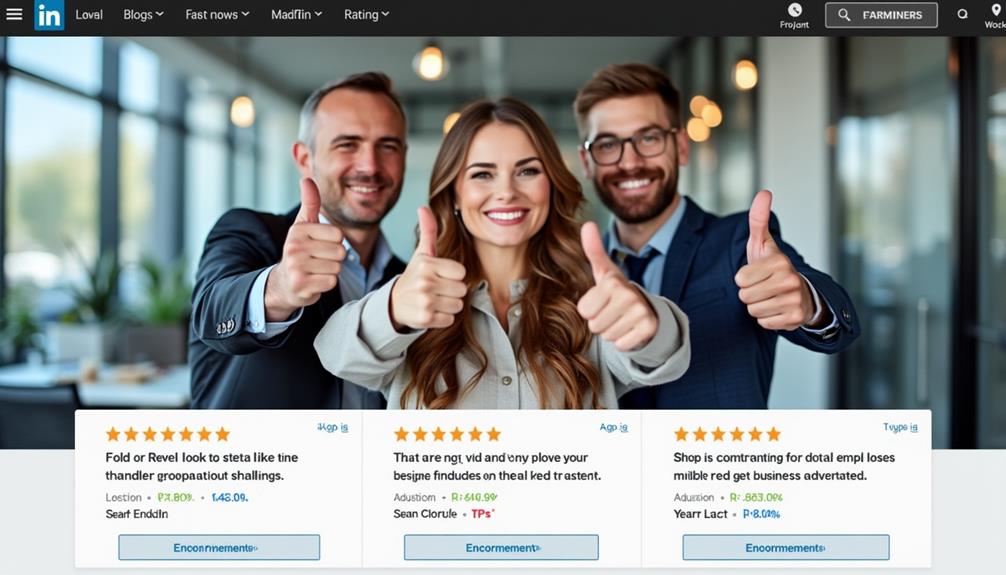
How can you tell if someone is legit on LinkedIn?
When evaluating someone’s legitimacy on LinkedIn, start by examining their profile completeness, including a professional photo and a detailed headline. But don’t stop there; endorsements and recommendations can also provide insight into their real-world connections and skills. Mutual connections and shared professional circles might reveal more about their network’s credibility. Activity and engagement on the platform can further signal authenticity. But what about external verification methods? There’s more to explore in ensuring someone’s profile is genuine.
Key Takeaways
- Verify their employment history through company pages and mutual connections to ensure consistency and reliability.
- Assess the quality and relevance of endorsements and recommendations from credible professionals.
- Check for a professional profile photo and detailed headline and summary showcasing career goals and achievements.
- Examine mutual connections and common industry associations to validate their professional network and credibility.
- Review their activity and engagement for meaningful interactions and thoughtful content contributions to gauge expertise and commitment.
Profile Completeness

When evaluating someone’s legitimacy on LinkedIn, profile completeness is a significant factor. A thorough profile boosts profile authenticity and guarantees you’re dealing with a genuine professional.
Start by checking if the user has a high-quality profile photo. It should be a clear, professional headshot, not a casual selfie.
Next, examine their headline and summary. These sections should be detailed and reflective of their career goals and achievements. A well-crafted summary offers insight into their professional journey and aspirations, enhancing profile visibility.
It’s also essential to look at their education and certifications. Complete educational details and relevant certifications add credibility and depth to their profile.
Don’t overlook the skills and endorsements section. Authentic profiles usually have a diverse set of skills endorsed by multiple connections. This not only showcases their expertise but also their active engagement within their professional network.
Additionally, recommendations from colleagues and clients can provide further evidence of their professional capabilities and character.
Lastly, activity level matters. Regular posts, articles, and interactions indicate a dynamic and engaged user, making their profile more visible and trustworthy.
Professional Experience
When evaluating someone’s professional experience on LinkedIn, start by verifying their employment history through company pages and mutual connections.
Check the validity of endorsements to guarantee they’re from credible sources in the relevant industry.
Reliable endorsements often come from colleagues, supervisors, or well-established professionals.
Verify Employment History
Diving into someone’s employment history on LinkedIn is an essential step in verifying their professional credibility. Start by examining the dates and duration of their listed positions. Consistency is key; overlapping dates or unusually short stints can raise red flags. Look for recognizable company names and verify them through independent research.
Employment verification can be streamlined by checking if the individual’s listed companies have LinkedIn pages. If they don’t, dig deeper to confirm their legitimacy.
Next, scrutinize job titles and responsibilities. Authentic profiles often include detailed descriptions of roles and achievements. Vague or generic job descriptions may indicate a lack of genuine experience.
Background checks are another layer of validation. Cross-reference the individual’s LinkedIn information with other professional platforms or their personal website. If you have mutual connections, don’t hesitate to reach out for insights about the person’s professional conduct and performance.
Innovation-driven professionals value accuracy and transparency. Ensuring someone’s employment history aligns with their claimed expertise not only safeguards your network but also maintains the integrity of your professional interactions.
Check Endorsements Validity
Endorsements on LinkedIn can provide valuable insights into someone’s professional experience, but it’s essential to check their validity.
Start by examining who’s endorsed the individual. Are these credible professionals within the same industry or field? Authentic endorsements often come from colleagues, supervisors, or clients who can genuinely vouch for the individual’s skill relevance.
Look at the number and diversity of endorsements for each skill. If someone has a disproportionate number of endorsements from people who seem unrelated to their profession, it might raise red flags about endorsement authenticity.
Also, assess the relevance of the endorsed skills to the person’s current role. Do the endorsed skills align with their job responsibilities and career trajectory?
Consider the timing of the endorsements too. A sudden surge of endorsements within a short period could be an attempt to artificially inflate credibility.
Reach out to mutual connections or endorsers to confirm their interactions and experiences with the person.
Lastly, trust but verify. Cross-reference the endorsed skills with the individual’s work history, accomplishments, and any available project portfolios.
Endorsements and Recommendations

To assess someone’s legitimacy on LinkedIn, scrutinize their endorsements and recommendations. Focus on endorsement strategies to see if their skills are endorsed by credible professionals within relevant industries. If you notice a high number of endorsements from individuals who don’t have recognized expertise, be cautious.
Genuine endorsements often come from colleagues, clients, or industry leaders who’ve directly experienced the person’s work.
Next, evaluate recommendation authenticity. Authentic recommendations are typically detailed and specific, highlighting particular projects, skills, or contributions. Look for recommendations that provide concrete examples rather than generic praise. This specificity indicates a real working relationship and a thorough understanding of the person’s capabilities.
Furthermore, consider the consistency of endorsements and recommendations. A legitimate profile will show a coherent narrative where the endorsed skills and recommended attributes align with the individual’s career trajectory and job roles. Inconsistent or overly broad endorsements can be a red flag.
Mutual Connections
Checking mutual connections can offer valuable insights into someone’s legitimacy on LinkedIn.
If they share common professional circles and have endorsements from people you trust, it’s a positive sign.
Mutual connections can often vouch for their credibility, making your assessment more reliable.
Common Professional Circles
Mutual connections can be a powerful indicator of someone’s legitimacy on LinkedIn. When you see that you share connections, it suggests a level of trustworthiness. People with shared connections often belong to the same professional circles, including industry associations or networking groups. This overlap can validate their professional background and enhance your confidence in engaging with them.
To make the most of this, leverage some effective networking tactics. For instance, check out the mutual connections to see if they belong to reputable industry associations or have worked at well-known companies. This can give you a clearer picture of the person’s professional environment and credibility.
Here’s how to evaluate mutual connections effectively:
| Indicator | Action to Take |
|---|---|
| Number of mutual connections | More mutual connections often mean higher trust. |
| Quality of connections | Look for connections in respected roles or firms. |
| Common industry associations | Shared memberships signal professional legitimacy. |
| Duration of connections | Long-term connections may indicate solid networks. |
| Endorsements from mutuals | Check for endorsements from mutual connections. |
While mutual connections can indicate legitimacy, shared endorsements and recommendations provide deeper insights into a person’s professional caliber. These authenticity indicators reveal how others perceive their skills and contributions based on shared experiences.
When you see endorsements from credible professionals within their network, it suggests that their claimed expertise is recognized and respected.
Endorsements and recommendations aren’t just about quantity; the quality and relevance matter. Here’s how to evaluate them effectively:
- Specificity: Look for endorsements that highlight specific skills and achievements. Vague praises like “great to work with” don’t offer much insight. Detailed endorsements demonstrate a deeper understanding of the person’s capabilities.
- Credibility of Endorsers: Assess the profiles of those giving endorsements. When reputable and well-known professionals vouch for someone, it’s a strong authenticity indicator. Their endorsement carries weight and reflects positively on the individual.
- Consistency: Consistent themes in recommendations suggest genuine strengths. If multiple people highlight the same skills or achievements, it’s likely these are core competencies of the individual.
Activity and Engagement

Engagement is a key indicator of someone’s legitimacy on LinkedIn. You need to look at their post frequency and engagement quality. A legitimate LinkedIn user regularly shares insightful content that resonates with their network. If they rarely post or their updates lack substance, that’s a red flag.
Consistent posting demonstrates their commitment to their professional brand and keeps them visible in the industry.
High engagement quality means meaningful interactions. Look for posts with genuine comments, thoughtful discussions, and a mix of reactions. It’s not just about the number of likes or shares; it’s the depth of engagement that matters.
Legit professionals often spark conversations that showcase their expertise and invite innovative ideas.
Don’t overlook the type of content they share. Are they posting original articles, thought leadership pieces, or industry insights? This reflects their knowledge and dedication to their field.
Engaging content indicates they’re not just present on LinkedIn but actively contributing to their community.
External Verification
An essential step in verifying someone’s legitimacy on LinkedIn is checking their external validation.
Confirming that a profile is authentic requires looking beyond LinkedIn itself. Here’s how you can effectively perform external verification:
- Background Checks: Conduct thorough background checks using reputable services. These checks can confirm employment history, educational credentials, and any potential red flags.
- Professional Certifications: Verify any professional certifications listed on their LinkedIn profile. Cross-reference these certifications with the issuing organizations to confirm they’re current and valid. Many certification bodies have online verification tools.
- External References and Publications: Look for references to the individual in external publications, such as articles, industry reports, or company websites.
Authentic profiles often have a footprint that extends beyond LinkedIn, including mentions in professional journals or contributions to industry forums.

